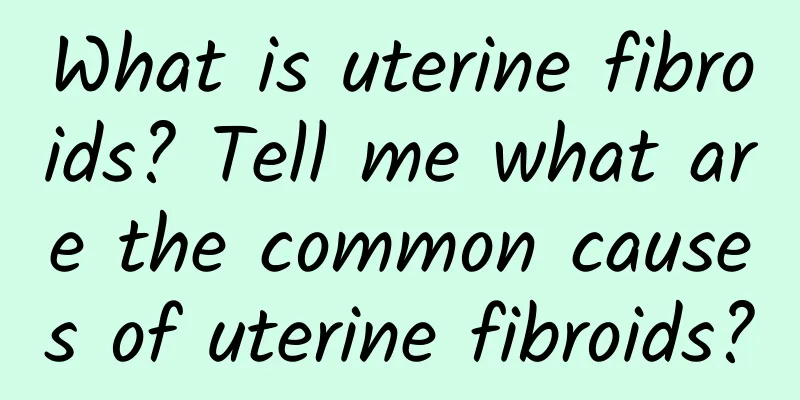What is uterine fibroids? Tell me what are the common causes of uterine fibroids?

|
What is uterine fibroids? Tell me what are the common causes of uterine fibroids? Uterine fibroids are a common benign tumor that mainly occurs in women of childbearing age. They are formed by the proliferation of uterine smooth muscle cells, usually growing inside the uterine wall, and sometimes inside the uterine cavity or outside the uterine wall. The size and number of uterine fibroids vary. Some people may have only one small tumor, while others may have multiple tumors at the same time. So, specifically, what is uterine fibroids? What are the general causes? This article will elaborate on these issues in detail. 1. Characteristics of uterine fibroids The main characteristic of uterine fibroids is the presence of a benign mass in or near the uterus. It usually grows slowly and may not cause any symptoms at first until the tumor grows larger or other complications occur, causing discomfort. Common symptoms include heavy menstruation, prolonged menstruation, irregular menstruation, intermenstrual bleeding, abdominal pain, backache, etc. Some tumors may compress the bladder and cause frequent and urgent urination, or compress the rectum and cause symptoms such as constipation. 2. Causes of uterine fibroids The cause of uterine fibroids is still unknown, but studies have shown that hormone levels and genetic factors may be related to their occurrence. The following are common causes of uterine fibroids: 1. Genetic factors: Studies have found that people with a family history are more likely to develop uterine fibroids. If there are members of the family with uterine fibroids, the individual's risk of the disease will increase. 2. Hormone levels: Estrogen is an important factor in the growth of uterine fibroids. The occurrence of uterine fibroids is related to the secretion level of estrogen. High levels of estrogen during pregnancy sometimes stimulate the growth of uterine fibroids. Therefore, infertile women are often associated with uterine fibroids. 3. Age factor: Uterine fibroids often occur during women's childbearing years, and the incidence rate is usually higher in women over 35 years old. 4. Weight and diet: Obesity and a high-fat diet may be associated with an increased risk of uterine fibroids. This is because fat cells can produce estrogen, which stimulates the growth of fibroids. 5. Other factors: Long-term use of oral contraceptives, long-term exposure to estrogen replacement therapy, traumatic uterine surgery, etc. may also increase the risk of uterine fibroids. Uterine fibroids are a common female disease. Although benign, they can still cause discomfort and pain to patients. Understanding the conditions and causes of uterine fibroids is essential for better treatment and prevention of the disease. To summarize, uterine fibroids are tumors formed by the proliferation of uterine smooth muscle cells, which appear as benign masses in or near the uterus. The causes of uterine fibroids may include genetic factors, hormone levels, age factors, weight and diet, etc. Although we cannot completely prevent uterine fibroids, by understanding their conditions and causes, we can better take measures to reduce the risk of disease and detect and treat the condition early. If you have the above symptoms, it is recommended to consult a doctor in time and undergo relevant examinations for early diagnosis and treatment. |
>>: What can I eat to shrink uterine fibroids and control their growth?
Recommend
I had my period on the 6th last month. When is the normal date for my period this month?
I had my period on the 6th last month, so it will...
What medicine should I take for a 2 cm uterine fibroid? Can a 2 cm uterine fibroid be eliminated by taking medicine?
What medicine should I take for a 2 cm uterine fi...
Will cervical adhesions cause intrauterine adhesions?
Cervical adhesions may lead to intrauterine adhes...
People who are suitable for medical abortion
Women with unexpected pregnancy can use artificia...
Expert introduction: Check the symptoms of adnexitis
Regarding the examination of adnexitis, you can g...
What should be paid attention to in the dietary conditioning of dysmenorrhea
What are the main dietary considerations for dysm...
Why does my menstruation never end?
Why does my menstruation never end? Menstruation ...
What are the symptoms of cervical erosion after microwave treatment? How to care for women after cervical erosion surgery?
In life, the impact of cervical erosion, a gyneco...
What causes hydatidiform mole?
Generally speaking, hydatidiform mole is caused b...
What about dyeing your hair during menstruation? It is not recommended to dye your hair
It is not recommended for women to dye their hair...
Life expectancy of patients with cervical erosion
Regarding the life expectancy of patients with ce...
What is the diagnosis of congenital absence of vagina?
What are the symptoms of congenital absence of va...
Tips for menstrual cramps: primary dysmenorrhea
Female friends who often suffer from dysmenorrhea...
What are the more common methods of bacterial vaginosis care?
The female genitals have a special physiological ...
How should women with uterine fibroids be treated? Common treatments for uterine fibroids
Women over 30 and under 50 have a high incidence ...









